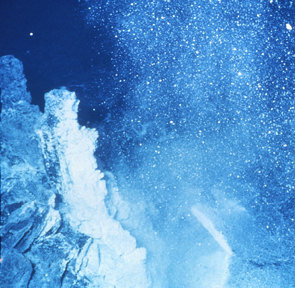Scientific Ocean Drilling of Mid-Ocean Ridge (MOR) and Ridge-Flank Settings
August 27-28, 2009 – Austin, Texas
Convener: Gail Christeson, Nick Hayman
August 27-28, 2009 – Austin, Texas
Convener: Gail Christeson, Nick Hayman
Overview
 Mid-ocean ridges accrete the world’s oceanic crust, cause the largest chemical interaction between the lithosphere and seawater, and host some of the most unknown biological systems in the world. Despite the importance of mid-ocean ridge systems, there remain outstanding first-order questions and open hypotheses about their internal structure and behavior. We classify these questions and hypotheses into four groups: (A) accretion of ocean crust and properties of the axial lithosphere, (B) crustal aging with seafloor spreading, (C) the circulation of fluids through the ocean crust and hydrothermal vents, (D) the distribution and diversity of biota. By bringing together scientists and engineers to discuss these hypotheses, we outlined a coordinated scientific agenda for drilling into young ocean crust, as well as the inherent technological challenges to be overcome to achieve drilling success in this geologic environment.
Mid-ocean ridges accrete the world’s oceanic crust, cause the largest chemical interaction between the lithosphere and seawater, and host some of the most unknown biological systems in the world. Despite the importance of mid-ocean ridge systems, there remain outstanding first-order questions and open hypotheses about their internal structure and behavior. We classify these questions and hypotheses into four groups: (A) accretion of ocean crust and properties of the axial lithosphere, (B) crustal aging with seafloor spreading, (C) the circulation of fluids through the ocean crust and hydrothermal vents, (D) the distribution and diversity of biota. By bringing together scientists and engineers to discuss these hypotheses, we outlined a coordinated scientific agenda for drilling into young ocean crust, as well as the inherent technological challenges to be overcome to achieve drilling success in this geologic environment.
Workshop Final Report (pdf)
White Paper Submitted to the INVEST Conference (pdf)
Article Published in Eos (pdf)
Meeting Materials
Presentation: Engineering in Support of Transformative Science (Greg Myers)
Williamson Deep Water Automated Coring System
Seafloor Geoservices Rovdrill
Benthic Geotech PROD Technology
MeBo Drilling Technology
IODP-MI Thematic Review: Ocean Crust Formation and Structure (2008)
Workshop Report: Requirements for Robotic Underwater Drills in U.S. Marine Geologic Research (2000)
Organizing Committee
Gail Christeson, University of Texas at Austin
Nick Hayman, University of Texas at Austin
Rachel Haymon, University of California, Santa Barbara
Mitch Schulte, University of Missouri-Columbia
Scott White, University of South Carolina
Sponsoring Organizations
U.S. Science Support Program
Jackson School of Geoscience, University of Texas at Austin